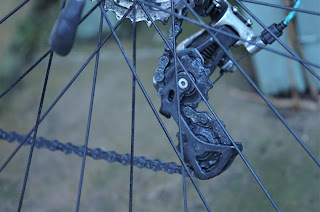Switched the fixed gear winter trainer back to the Mavic/Halo Fixed-G Track Hub HALO FIX G TRACK HUB | Seven Day Cyclist Tourin Tests Commuting and I’d fed the chain some BAT Wax chain lube. Now, sweeping, broad strokes statements are inaccurate by definition. Caveat established; traditional wax lubes tend to be remarkably similar in terms of application, durability, and performance.
The biggest similarity is their need for surgically clean host transmissions. Particularly true of emulsion/water-based blends, which will simply float away, if there’s the faintest trace of petrochemical product clinging to the rollers.
In some instances, say, if I’ve been running a wet lube for a few weeks prior, I may well remove ring(s) and cassette(s) and leave them soaking in a degreaser stock, such as Squirt Bike Degreaser Concentrate SQUIRT BIKE CLEANER CONCENTRATE | cycling-not-racing (sevendaycyclist.com) or in the context of stainless/polished components, a master-blaster potion, such as Green Oil Agent Apple extreme Immersion Degreaser. TESTED: GREE OIL AGENT APPLE EXTREME IMMERSION DEGREASER (sevendaycyclist.com)
Drivetrain immaculate, the wax can be applied. Bat follows the traditional shake and allow four hours curing time narrative. However, though the flow rate is good, and it seeps deep into the links, the thicker viscosity means it clings to the chain, rather than engulfing the floor and anything else in proximity. This could be attributable to the sudden dip in temperature but then I wouldn’t expect the wax to flow steadily. Will be interesting to see what the next few weeks bring.
A few fast blasts over the easter weekend suggest it's smooth and friction is low. Whether it will rival some ceramic blends, such as Weldtite TF2 Advanced Ceramic Chain Wax TEST & REVIEW: WELDTITE TF2 ADVANCE CERAMIC CHAIN WAX (sevendaycyclist.com) remains to be seen. Nonetheless, the Bat Wax has made me sit up and take notice. Nice to have the Fix-G set up right again. Present gearing (700x32 165mm cranks and 16T) is now 70.9 inches, which translates as 19mph average and means I’m not busting my knees on shorter, sharper climbs.
Not a new model by any means but I love the system’s design, which allows precision chain line and therefore, zero noise. An eccentric bottom bracket is the other solution but not one commonly employed on fixed gear builds.
The Univega’s eagerly awaited XT/Rigida Sputnik wheel also arrived this week. I planned to leave it waiting in the wings while getting my final miles from the cheap but very cheerful Mach/Deore pairing. I went to consult my equine guru regards Ursula’s gearing. Seems I have been shunned, so will stick with the 12-25 until hyper-intelligent horse people say otherwise.
Being a bank holiday, plans changed. Closer inspection suggested the rim was beginning to show signs of fatigue. Decision made. Out came the Pedros Vise Whip and trusty Cyclo cassette tool. Despite a liberal helping of Park grease on the lock ring, a quick blast of GT85 was needed before it would release.
In keeping with other, bike (and non) related work, there are a wealth of views re-greasing freehub splines.
I’m of the “add a thin layer” camp, although as many will point out, there’s little risk of galvanic seizure between the two components. More important is to grease the lockring threads with a suitably stout prep. Assuming you’re not using exotic components, old-school lithium should be fine, but I err towards synthetics for peace of mind.
I also prefer tools with guide pins, since these afford more stability and ensure tool and splines engage flush, so no risk of slip damage.
Cassette, rim tape, and skewer swapped, I disposed of the old hoop and fed the chain some Bat Wax, since I was there and because I am curious to see whether it will behave like other waxes on a derailleur setup. Temperatures in the mid-teens haven’t impacted on the lube’s flow rate or seen the lion’s share on the concrete beneath, which is a very welcome surprise. However, the proof of any lube is in the riding, so I’ll plod on.

















